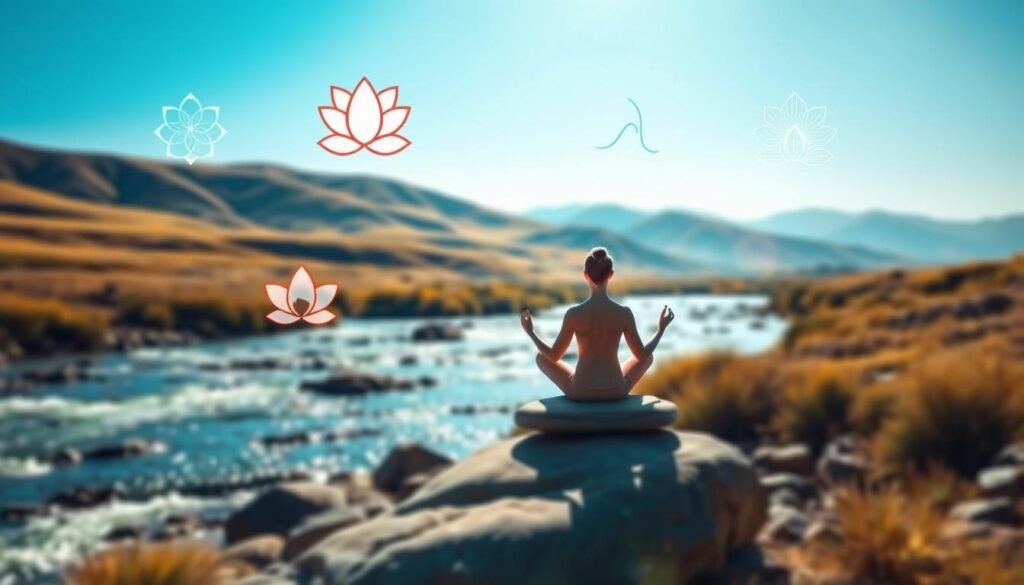A study in JAMA Internal Medicine showed that mindfulness meditation helps reduce anxiety and depression. This was seen in over 3,500 people, highlighting the importance of taking care of our mental health. Through meditation and breathwork, individuals can experience lasting relief from anxiety. Just a few minutes each day can make a big difference. By combining these two, people feel more peaceful every day. This change helps them handle stress better.
Combining meditation with breathing exercises can greatly improve mental health. It makes us better at dealing with life’s tough moments. Studies back this up, showing these practices not only lessen symptoms but also create inner peace. This peace makes us stronger and more peaceful.
Key Takeaways
- Short daily practices of meditation and breathwork can significantly reduce anxiety symptoms.
- Mindfulness techniques offer tools for emotional resilience and coping with stress.
- Combining meditation with breathing provides a holistic approach to mental well-being.
- Tailoring breathing and meditation practices can enhance their effectiveness in anxiety management.
- Studies show consistent practice leads to long-term improvements in overall well-being.
Understanding Anxiety and Its Effects
Anxiety is a common response when stressed. It shows up as worry, nervousness, or unease. These feelings usually link to upcoming events or situations. Learning about anxiety and its impact is key to understanding mental health.
What Is Anxiety?
Anxiety isn’t just temporary worry. It includes various disorders marked by fear and worry. It affects many people and can disturb daily life. Anxiety sometimes feels normal, but ongoing disorders need attention. They can deeply affect someone’s emotional and psychological state.
The Physiological Impact of Anxiety on the Body
The body reacts physically to anxiety in different ways. These reactions include:
- Increased heart rate
- Elevated blood pressure
- Muscle tension
- Problems with digestion
- Sleep issues
This happens because of the fight-or-flight response during stress. The COVID-19 pandemic saw many reporting anxiety. This shows the common emotional responses during crises. Mindfulness therapy has been helpful in dealing with such symptoms. For more on breathing exercises, check this source.
Common Symptoms of Anxiety Disorders
Those with anxiety disorders often show many symptoms. They include:
- Excessive worry or thinking too much
- Feeling restless or on edge
- Having trouble focusing
- Being very tired
- Sweating or shaking
It’s crucial to recognize these symptoms early. Doing so can help manage them better, enhancing mental health. Seeking support and using methods like meditation and breathing exercises can greatly help. These strategies improve life quality by lessening anxiety impacts.
The Role of Meditation in Reducing Anxiety
About 1 in 5 people suffer from anxiety disorders. Many methods help manage these feelings, and meditation is quite effective. It helps us focus on now, moving away from stress. This not only lessens anxiety but also betters mental health overall.
How Meditation Works for Relaxation
Meditation calms the mind and soothes the nervous system. In mindfulness meditation, we watch our thoughts without judging them. This leads to a relaxation response, lowering stress. Studies show meditation regularly can greatly reduce anxiety symptoms. People meditating showed a notable improvement.
Types of Meditation Techniques for Anxiety Relief
There are many meditation techniques for easing anxiety. Mindfulness meditation focuses on present awareness and is very helpful. Guided meditation, either led by someone or an app, offers structured support. These methods are rooted in tradition but fit our modern life well. For more, check out resources like mindfulness-based interventions online or through apps.

Breathing Techniques for Anxiety Management
Breathing exercises are key for managing anxiety. They help us relax and lower stress levels. When we learn these techniques, we can use them daily to feel better overall. These methods calm us down in stressful situations by activating a part of our nervous system.
What Are Breathing Exercises?
Breathing exercises involve controlling our breath to relax and lessen anxiety. They give quick relief and also help us deal better with stress in the future. Anyone who feels anxious or stressed can benefit from these calming exercises.
Popular Breathing Techniques
- Diaphragmatic Breathing: Inhale for 4 seconds, hold for 2 seconds, and exhale for 6 seconds. This technique helps remove tension and encourages relaxation.
- Box Breathing: Each phase lasts 4 seconds—inhale, hold, exhale, and hold. This rhythmic breathing promotes mental clarity and relaxation.
- 4-7-8 Breathing: Inhale for 4 seconds, hold for 7 seconds, and exhale for 8 seconds. This method is particularly effective for stress reduction.
- Nadi Shodhana (Alternate Nostril Breathing): This involves breathing through alternating nostrils. It’s known for balancing the nervous system and promoting relaxation.
- Resonance Breathing: Involves breathing at a rate of 5-6 breaths per minute, which can help relieve anxiety and stabilize emotional states.
Benefits of Controlled Breathing for Anxiety Relief
There are many benefits to breathing exercises for anxiety management, including:
| Benefit | Description |
|---|---|
| Reduces Stress Levels | Helps decrease cortisol levels, promoting a sense of calm. |
| Enhances Focus | Improves concentration by facilitating mental clarity. |
| Promotes Relaxation | Encourages parasympathetic nervous system activity, leading to muscle relaxation. |
| Improves Respiratory Function | Encourages deeper and more effective breathing patterns. |
Combining Meditation with Breathing Exercises for Anxiety
Meditation mixed with breathing exercises can greatly lower stress. These methods work together, caring for both mind and body. Learning to combine them can deeply reduce stress and better manage emotions.
How These Two Practices Complement Each Other
Meditation and breathing exercises are a strong duo for anxiety relief. Breath focus starts the body’s calm response. It slows the heart and drops blood pressure. Quick, shallow breaths can make us dizzy and speed up our heart. Controlled breathing can fix this, making us calmer. This calmness adds to meditation’s benefits.
Creating a Routine with Meditation and Breathing
Having a daily meditation and breathing routine is key. Aim for 10 to 20 minutes a day, ideally at a set time. Techniques like box breathing and the 4-7-8 method should increase focus and relaxation. Mindfulness, like color breathing, goes well with deep breathing for more emotional insight. Learn how to combine these practices for a better routine.
| Technique | Description | Benefits |
|---|---|---|
| Box Breathing | Inhale for 4 seconds, hold for 4 seconds, exhale for 4 seconds, hold for 4 seconds. | Reduces stress, enhances focus, improves decision-making. |
| 4-7-8 Breathing | Inhale for 4 seconds, hold for 7 seconds, exhale for 8 seconds. | Promotes relaxation, improves sleep quality, calms the nervous system. |
| Diaphragmatic Breathing | Breathing deeply into the diaphragm rather than the chest. | Reduces tension, fosters a sense of calm, improves oxygen intake. |
Adding these methods to your day can change how you handle anxiety. With regular practice, you’ll see not just less anxiety. You’ll also feel more mentally clear and emotionally balanced.
Mindfulness Breathing Exercises for Calming the Mind
Today’s world moves fast, so controlling stress is key for a healthy mind. Mindfulness breathing exercises are vital for relaxation, helping people focus and lower anxiety. They make it easier to live in the moment, calm the mind, and feel peaceful.
The Importance of Mindfulness in Stress Relief
Mindfulness is key to reducing stress. When you focus on your breath mindfully, you control your emotions better and improve your well-being. Studies show doing this every day can make you more alert and less burned out at work. Plus, it can boost your heart’s health and lower high blood pressure, protecting against heart problems.
Examples of Mindfulness Breathing Exercises
- Deep Breathing: Breathe in slowly through the nose, letting your belly rise. Then breathe out gently through the mouth. This method helps you relax and feel less anxious.
- Box Breathing: Breathe in for four counts, hold for four, breathe out for four, and hold for four again. This pattern can sharpen your focus and relieve stress.
- Counting Breaths: Count each breath up to ten, then start over. It’s a simple way to boost focus and calmness.
- Body Scan Meditation: Pay attention to different body parts while taking deep breaths. It increases awareness and helps release tension, making you relaxed.

Using mindfulness breathing exercises daily can greatly help with anxiety control. Just a few minutes every day can transform your life. You’ll become more positive and better at handling stress as you become more mindful.
| Breathing Exercise | Benefits |
|---|---|
| Deep Breathing | Reduces anxiety, enhances relaxation |
| Box Breathing | Improves focus, calms nervous system |
| Counting Breaths | Increases awareness, decreases rumination |
| Body Scan Meditation | Promotes relaxation, relieves tension |
By regularly doing these mindfulness breathing exercises, you can effectively relieve stress and clear your mind.
Specific Meditation Techniques for Anxiety Reduction
Many people fight with anxiety daily. Looking into meditation techniques proves helpful for calmness. Guided meditation and mindfulness stand out for mental peace.
Guided Meditation for Anxiety Relief
Guided meditation is led by a teacher. They take you through images and breathing exercises. It helps with anxiety, mood, and pain.
During these sessions, calming places are imagined, bringing peace. It’s a way to understand your thoughts in a kind space.
Mindfulness Meditation Practices
Mindfulness meditation focuses on the now. It helps you see thoughts without judging them. This lowers anxiety by making you aware of your emotions.
Body scan meditations help relax by checking in with your body. Loving-Kindness Meditation switches negative thoughts to positive ones. Visualization takes your mind to calm places.

| Meditation Technique | Benefits |
|---|---|
| Guided Meditation | Reduces anxiety and pain, fosters mindfulness through structured sessions |
| Body Scan Meditation | Promotes relaxation, increases body awareness, and relieves physical tension |
| Loving-Kindness Meditation | Enhances emotional resilience by replacing negative thoughts with positivity |
| Mindfulness Meditation | Improves self-awareness, allows for acceptance of thoughts without judgment |
| Visualization Techniques | Helps manage anxiety by transporting the mind to calming environments |
Adding these meditation methods to your day can change your life. They offer not just quick relief but also long-term emotional strength.
Benefits of Combining Both Practices
Merging meditation and breathing exercises brings many good things for our minds and bodies. By doing these regularly, people can see big positive changes in how they feel overall.
Improved Mood and Reduction of Anxiety Symptoms
Meditation and controlled breathing together make moods better. Studies show they lower anxiety and depression. This mix helps people relax, deal easier with stress, and get stronger emotionally.
Physical Health Benefits of Daily Practice
Doing meditation and breathing exercises often is great for your health. They can lower blood pressure and help your heart work better. This can lead to a longer, healthier life. Diaphragmatic breathing, a simple technique, is key for feeling good every day.
Enhancing Mind-Body Connection
Combining meditation and breathwork makes the connection between mind and body stronger. It helps people notice their thoughts and feelings more. Being more mindful helps with controlling emotions. It also makes people less worried about things that have happened or might happen.
Tips for Beginners: How to Start Practicing
Starting with meditation and breathing exercises is a rewarding path. It is key for those looking to handle anxiety to make their space cozy and welcoming. This helps create the right setting for deep relaxation and focus, which are vital for good meditation.
Creating a Comfortable Environment for Practice
First, pick a quiet place away from any distractions. Decorate it with peaceful items like cushions, blankets, or candles. Whether it’s a quiet corner of your home or a tranquil garden spot, it works. The lighting is also important; soft, warm lights or natural sunlight make the space better.
- Keep the space clean and clutter-free.
- Consider the room’s temperature to maintain comfort.
- Incorporate calming scents, such as lavender or eucalyptus.
Making these changes helps newcomers focus better during meditation. This can lead to less anxiety and better concentration.
Finding the Right Resources and Guidance
Finding the right sources for meditation is crucial for beginners. There are many apps and websites with guided meditations, beginner tips, and techniques. For example, Mindful.org offers great advice for starting a regular meditation habit.
| Resource Type | Examples | Benefits |
|---|---|---|
| Apps | Calm, Headspace | Offer guided meditations for anxiety relief |
| Books | The Miracle of Mindfulness by Thich Nhat Hanh | Provide insights into mindfulness techniques |
| Online Courses | Mindfulness-Based Stress Reduction (MBSR) | Structured learning for consistent practice |
| Local Classes | Community centers, yoga studios | Personal interaction with instructors |
Starting meditation is a big step towards managing anxiety better. By preparing a supportive space and using the right resources, beginners can enjoy their meditation journey to the fullest.
Common Challenges and Misconceptions
Meditation and breathing exercises often face common challenges. Many people find it hard to start these practices. A busy lifestyle, wrong ideas about meditation, or fear of not doing it right can stop them.
Overcoming Resistance to Meditation and Breathing
Many misunderstand meditation. They think they must clear their minds completely to do it right. Instead, meditation is about noticing thoughts without judgment. This method helps make meditation seem more possible, accepting even discomfort as part of the process.
- Start with short sessions, even just a few minutes can provide benefits.
- Explore different styles of meditation, like Qi Gong or Tibetan Buddhist meditation, to find what resonates.
- Utilize guided meditations or apps, which can offer support and structure.
- Combining breathing exercises can ease stress and enhance the experience.
Addressing Misconceptions about These Practices
Some misconceptions about meditation are believing you must feel bliss right away or that falling asleep is failing. Every feeling during meditation is valid. Studies show meditation can help reduce stress and bad mental habits, but its long-term results are not guaranteed.
It’s good to meditate with kindness towards yourself. Using mantras or reflection can help you have a better relationship with your thoughts and feelings. For more on these techniques for easing anxiety, visit this resource.
Conclusion
Meditation combined with breathing exercises is great for mental health and well-being. Scientific research backs this up, showing that even short daily sessions can make you feel better and less anxious. For example, just 5 minutes of breathwork or mindfulness can calm you down by activating the body’s relaxation response.
Some methods, like cyclic sighing and slow breathing, are really good at improving how we breathe and feel. They help people feel less anxious and stressed by fitting into their daily lives. These practices also lower blood pressure, reduce stress hormones, and help us focus and feel happier.
Choosing to combine meditation and breathing exercises for anxiety relief is a smart move for better mental health. Doing these practices regularly not only helps with stress management but also connects our mind and body. This leads to a more balanced and happy life.